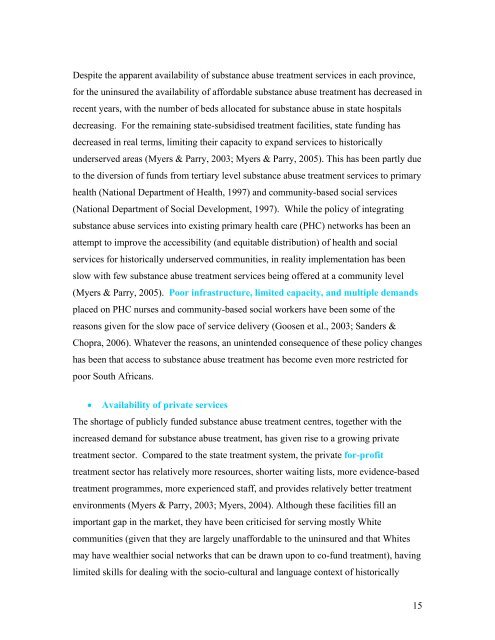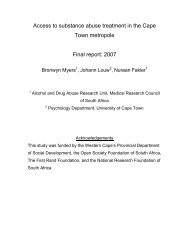Development, 1997; 2006). Despite this, concerns about disparities <strong>in</strong> health and socialwelfare service provision between the socially advantaged and the socially disadvantagedrema<strong>in</strong>; with socio-economic disadvantage still associated with race <strong>in</strong> South Africa -despite a grow<strong>in</strong>g Black middle class (Sanders & Chopra, 2006). Given these <strong>in</strong>equities,it is plausible that similar racial <strong>in</strong>equities exist <strong>in</strong> the substance abuse treatment sector.To some extent, these concerns seem justified. Accord<strong>in</strong>g to recent f<strong>in</strong>d<strong>in</strong>gs from theSouth African Community Epidemiology Network on Alcohol and Drug <strong>Abuse</strong>(<strong>SA</strong>CENDU) (Myers, 2004; Myers & Parry, 2005) and audits <strong>of</strong> specialist substanceabuse treatment facilities <strong>in</strong> Cape Town (Myers & Parry, 2003) and Gauteng andKwaZulu-Natal (Myers & Fakier, 2007), the race pr<strong>of</strong>ile <strong>of</strong> clients at specialist treatmentfacilities does not reflect the demographics <strong>of</strong> the general population. Throughout thecountry, there has been an under-representation <strong>of</strong> Black and an over-representation <strong>of</strong>White South Africans <strong>in</strong> treatment facilities. This pattern <strong>of</strong> service utilisation reflectsthe limited extent to which Black South Africans have access to substance abusetreatment rather than lower levels <strong>of</strong> substance use by these racially-def<strong>in</strong>ed social groups(Myers, 2004; Myers & Parry, 2005; Myers & Fakier, 2007) and highlights theimportance <strong>of</strong> rout<strong>in</strong>ely exam<strong>in</strong><strong>in</strong>g service system factors associated with access tosubstance abuse treatment.1.3.3. Factors associated with disparities <strong>in</strong> access to substance abuse treatment• Availability <strong>of</strong> public servicesDebate about the accessibility <strong>of</strong> services for historically disadvantaged groups hascentred on structural and environmental factors that restrict access to services forBlack South Africans. More specifically, concerns have been raised about the limitedavailability <strong>of</strong> affordable substance abuse treatment facilities. In South Africa, themajority <strong>of</strong> the population (80%) are without medical <strong>in</strong>surance and rely heavily on thestate sector to provide health and social welfare services (Goosen, Bowley, Degiannis, &Plani, 2003) <strong>in</strong>clud<strong>in</strong>g substance abuse treatment. As with other services, the un<strong>in</strong>suredare disproportionately represented by poor, Black South Africans (Goosen et al., 2003).For this sector <strong>of</strong> the population, there are few state-funded substance abuse treatmentfacilities and access to these facilities is hampered by lengthy wait<strong>in</strong>g lists <strong>of</strong> up to sixmonths (Myers, 2004; Myers & Parry, 2003).14
Despite the apparent availability <strong>of</strong> substance abuse treatment services <strong>in</strong> each prov<strong>in</strong>ce,for the un<strong>in</strong>sured the availability <strong>of</strong> affordable substance abuse treatment has decreased <strong>in</strong>recent years, with the number <strong>of</strong> beds allocated for substance abuse <strong>in</strong> state hospitalsdecreas<strong>in</strong>g. For the rema<strong>in</strong><strong>in</strong>g state-subsidised treatment facilities, state fund<strong>in</strong>g hasdecreased <strong>in</strong> real terms, limit<strong>in</strong>g their capacity to expand services to historicallyunderserved areas (Myers & Parry, 2003; Myers & Parry, 2005). This has been partly dueto the diversion <strong>of</strong> funds from tertiary level substance abuse treatment services to primaryhealth (National Department <strong>of</strong> Health, 1997) and community-based social services(National Department <strong>of</strong> Social Development, 1997). While the policy <strong>of</strong> <strong>in</strong>tegrat<strong>in</strong>gsubstance abuse services <strong>in</strong>to exist<strong>in</strong>g primary health care (PHC) networks has been anattempt to improve the accessibility (and equitable distribution) <strong>of</strong> health and socialservices for historically underserved communities, <strong>in</strong> reality implementation has beenslow with few substance abuse treatment services be<strong>in</strong>g <strong>of</strong>fered at a community level(Myers & Parry, 2005). Poor <strong>in</strong>frastructure, limited capacity, and multiple demandsplaced on PHC nurses and community-based social workers have been some <strong>of</strong> thereasons given for the slow pace <strong>of</strong> service delivery (Goosen et al., 2003; Sanders &Chopra, 2006). Whatever the reasons, an un<strong>in</strong>tended consequence <strong>of</strong> these policy changeshas been that access to substance abuse treatment has become even more restricted forpoor South Africans.• Availability <strong>of</strong> private servicesThe shortage <strong>of</strong> publicly funded substance abuse treatment centres, together with the<strong>in</strong>creased demand for substance abuse treatment, has given rise to a grow<strong>in</strong>g privatetreatment sector. Compared to the state treatment system, the private for-pr<strong>of</strong>ittreatment sector has relatively more resources, shorter wait<strong>in</strong>g lists, more evidence-basedtreatment programmes, more experienced staff, and provides relatively better treatmentenvironments (Myers & Parry, 2003; Myers, 2004). Although these facilities fill animportant gap <strong>in</strong> the market, they have been criticised for serv<strong>in</strong>g mostly Whitecommunities (given that they are largely unaffordable to the un<strong>in</strong>sured and that Whitesmay have wealthier social networks that can be drawn upon to co-fund treatment), hav<strong>in</strong>glimited skills for deal<strong>in</strong>g with the socio-cultural and language context <strong>of</strong> historically15
- Page 1 and 2: Alcohol & Drug Abuse Research UnitM
- Page 3 and 4: 3.1.2 Treatment facility profile by
- Page 5 and 6: 4.3 Targeting barriers to treatment
- Page 7 and 8: EXECUTIVE SUMMARYA cross-sectional
- Page 9 and 10: services to historically underserve
- Page 11 and 12: use, reductions in criminal activit
- Page 13: Despite high levels of substance ab
- Page 17 and 18: treatment services provided. At pre
- Page 19 and 20: use disorders whose physical and em
- Page 21 and 22: delivery, treatment retention, and
- Page 23 and 24: audit substance abuse treatment fac
- Page 25 and 26: 2.8.3. Further data considerations
- Page 27 and 28: Figure 1. Inpatient intensity of ca
- Page 29 and 30: Since there is a large overlap betw
- Page 31 and 32: the total client population (χ = 4
- Page 33 and 34: Figure 7.Comparison of race profile
- Page 35 and 36: services per month ranges from 13 t
- Page 37 and 38: 3.4.1. Characteristics of staff at
- Page 39 and 40: supervision. In contrast, a much sm
- Page 41 and 42: In terms of client record-keeping,
- Page 43 and 44: Core findings:• Compared to the p
- Page 45 and 46: using 12-step approaches, 75.0% rep
- Page 47 and 48: Figure 16. Proportion of treatment
- Page 49 and 50: 3.7. ADDRESSING BARRIERS TO TREATME
- Page 51 and 52: Table 11. Proportion of facilities
- Page 53 and 54: Table 12. Proportion of facilities
- Page 55 and 56: Figure 20.Proportion of substance a
- Page 57 and 58: Table 14. Proportion of facilities
- Page 59 and 60: Table 15. Proportion of facilities
- Page 61 and 62: 3.9.2. Monitoring of clients’ pro
- Page 63 and 64: Table 16. Proportion of facilities
- Page 65 and 66:
PART 4: DISCUSSION OF KEY FINDINGSW
- Page 67 and 68:
previous audits of specialist subst
- Page 69 and 70:
small proportion of South African d
- Page 71 and 72:
high levels of substance use among
- Page 73 and 74:
these barriers appears to significa
- Page 75 and 76:
appropriate services for Black/Afri
- Page 77 and 78:
clients progress post-treatment, an
- Page 79 and 80:
• The number of state facilities
- Page 81 and 82:
• Another way of ensuring (indire
- Page 83 and 84:
• The age appropriateness of serv
- Page 85 and 86:
REFERENCESAllard, S.W., Tolman, R.M
- Page 87 and 88:
Myers, B., & Fakier, N. (2007). Rep
- Page 89:
Zule, W.A., Lam, W.K., & Wechsberg,
















